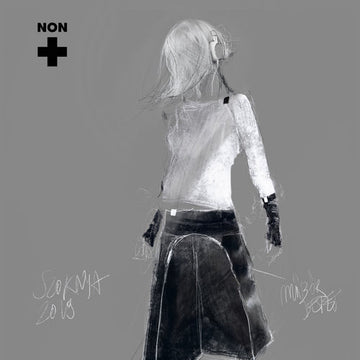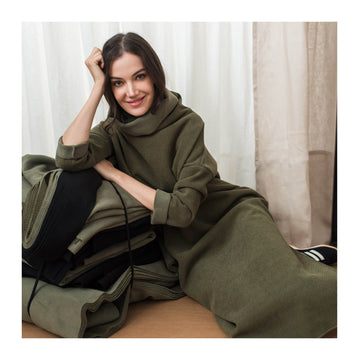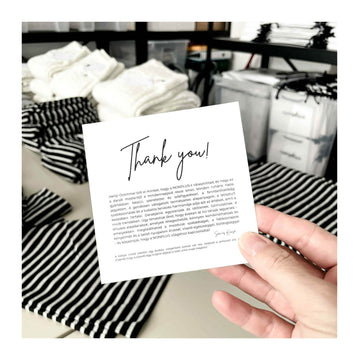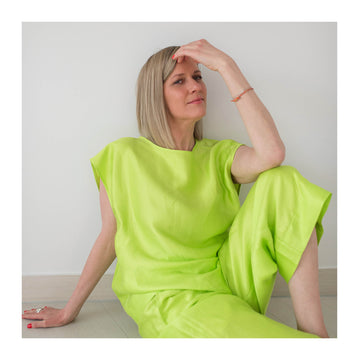On the occasion of Design Week Budapest, we are presenting a special, limited edition capsule collection. The styles of the NON+ PINTO capsule collection are inspired by the style of equestrian clothing in the spirit of restrained female energy. The limited edition styles were dreamed up by set and costume designer Borbála Kiss in the monochrome color scheme typical of NON+, which is why the collection is named after the black and white spotted horse breed. We spoke to Bori about the release of the collection.
- What did you want to be when you were little and how did you become a visual designer?
- Princess. There was a time when I was a teenager when I wore only skirts. I even went sledding in a skirt... For example, once at home I made myself a hoop out of cardboard and string under my skirt and went to school in it. Of course, after the first lesson - as soon as I sat down at the desk - the cardboard hoops lost their hold and I had to peel them off during recess. I didn't give up on this dream for a long time: so I trained to be an actress.
I studied drama in high school, then graduated from the acting studio at the Hevesi Sándor Theatre in Zalegerszeg. It was an intensive theatrical lifestyle, varied and exciting. I gained insight into almost every detail of creating a performance. From there I came to Kaposvár to study visual design. Since then I have been working as a set and costume designer.

- How is the visuals of a theatrical production created? How much free rein do you usually get in terms of creativity?
- First, I get acquainted with the text, the director's concept. I pay attention to what impressions I have, how the text touches me, or simply put: "what is my personal connection to it". The historical period, the dramaturgy of the play, its musical texture (not only musical plays have it), the behavior of the characters trigger a rich and intense wave of associations in me. I let these images and moods wash over me for a few days, both in a waking and sleeping state. Then I start scribbling.
I am very grateful when I get a free hand from the director. Of course, it is a matter of trust. At the same time, it is natural that when I work with someone for the first time and we don't know each other yet, they set certain boundaries.

- What characterizes your style - whether in the field of fashion design or visual design? How do you see it changing (if it has changed) over the past years?
- “Style is nothing more than the order and momentum that we bring to our thoughts,” says the count. There is no style without the person who wears the clothes. In a theatrical play, the personality, habits, and desires of the given character determine what they wear. It is no different in our everyday lives. For my part, perhaps the design attitude could be formulated as being primarily interested in the person: their complexity, their different layers, and their secret desires. I like it when the clothes I design have more than one interpretation.
- What do you like most about your profession?
- The investigation. It may be surprising, but I often feel like a detective. Before planning, you always have to untangle the threads, understand the cause-and-effect relationships, investigate the motives and examine the entire process of the story. It is particularly exciting that the creative partners: the director, the dramaturge, the composer, the choreographer, the lighting designer and, during the rehearsal process, the actors sometimes seek and formulate the same truth from different perspectives, but with their own artistic tools. There can be very inspiring encounters during a creative process.

- Where do you work, where can we see your work?
- Right now, the Griff Puppet Theatre in Zalegerszeg is preparing the performance The Snow Queen, directed by Péter Mihály, the production process has begun, and rehearsals will begin in mid-October. After that, we are preparing for the performance of The Little Prince, directed by Artúr Vranyecz, in a co-production between the Csokonai Theatre in Debrecen and the Csodamalom Puppet Theatre in Miskolc.
- Tell us about the collection you designed for NON+ for this year's Design Week. What inspired you and how was the collaboration with Saci?
- This is not my first design for NON+, we have worked together with Saci before. As I said then, for me it is a celebration: an elevated, expectant, joy-filled period. The current collection was inspired by equestrian clothing. I am interested in the fact that sooner or later there comes a time in a person's life when the youthful, instinctive, dynamic and free feeling of life is replaced by a more disciplined, responsible, and at the same time more complex stage of thinking. There is a wild, unbridled primal energy somewhere in every woman. But there is nothing more attractive, more mysterious and elegant than when a woman manifests herself by controlling these original energies. If she does it with dignity: that is art. At the same time, behind the self-restraint and discipline, a certain irresistible force always shines through, a certain irresistible force is subtly felt. This elegance is suggested by the collection.

- How difficult is it for you to “adapt” to the clean use of materials and style of NON+? Was this even a goal when designing the collection?
- The motto of NON+ is simplicity, clarity, so of course I tried to make the collection fit the image of NON+, but I wouldn't say that it was particularly difficult. It was more of a kind of playfulness, an exercise in style . And it so happened that this kind of restraint specifically strengthened the message of the collection. I would add that from a professional point of view, the clear style carries a much greater risk in terms of the possibility of error, meaning that even a small mistake can be extremely spectacular, but Saci's presence in itself was a guarantee that a professional and qualitatively perfect collection would be born.
- What are you working on now, what are your current plans?
- I have theatrical plans, and several things are maturing in me related to them. These goals are fragile, malleable, vulnerable. They say “darkness is the time of scents, darkness is the time of vision, darkness is the time of discoveries that are not possible in the light.” Planning is an exciting time, whether it concerns life or we are talking about it professionally. On the way to realization, anything is still possible.
Photo: Lenke Kiss 'Dalocska'
Model: Laura Farkas
Makeup, hair: Lívia Varró
Shoes: Vagabond









